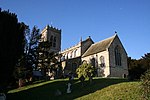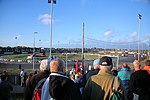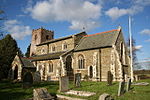Dobson's Mill

Dobson's Mill is a tower windmill for grinding wheat and corn. It stands in the High Street in the town of Burgh le Marsh, near Skegness in Lincolnshire, England. The mill was, prior to damage by Storm Ciara on 9 February 2020, open to the public as a tourist attraction and is a Grade I listed building. The mill site also houses the Burgh-le-Marsh Heritage Centre. The windmill was built and fitted out by Sam Oxley, an Alford millwright, in the early 1800s for the Jessop family, who baked bread on the same site. It was completed by 1844. Dobson was the name of the last miller. The mill is built in five storeys of tarred brick and was fitted with five sails (also termed "sweeps"), unusual in that they turned clockwise, driving three sets of millstones (two pairs of grey stones and one pair of French) in an anti-clockwise direction. There is a blocked opening on the ground floor where a steam traction engine once powered an extra set of millstones. The mill was purchased by the local Council in the 1960s and refurbished, including the installation of a new cap and sails, in 2014. On 9 February 2020 the cap and sails were destroyed by winds from Storm Ciara. The 16-tonne sails landed on the adjacent Granary Heritage Displays, which were reopened in May 2023. It is planned to reinstate the sails, with the work hoped to be completed by 2026.
Excerpt from the Wikipedia article Dobson's Mill (License: CC BY-SA 3.0, Authors, Images).Dobson's Mill
High Street, East Lindsey Burgh le Marsh
Geographical coordinates (GPS) Address Nearby Places Show on map
Geographical coordinates (GPS)
| Latitude | Longitude |
|---|---|
| N 53.1606 ° | E 0.2477 ° |
Address
Granary Tearoom
High Street
PE24 5JT East Lindsey, Burgh le Marsh
England, United Kingdom
Open on Google Maps










